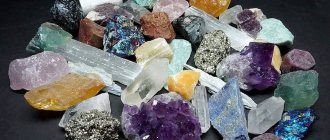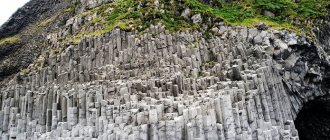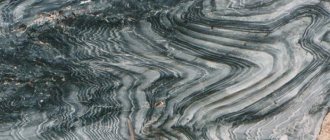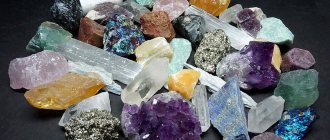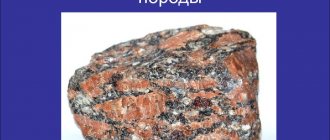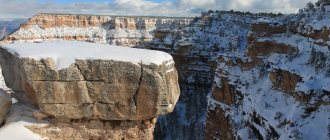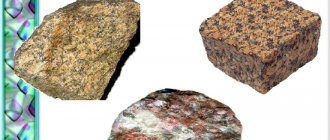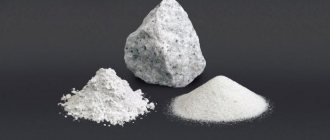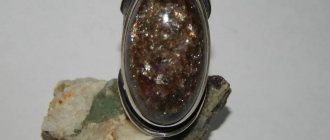Minerals are natural bodies that occur naturally. They are formed as a result of various physical and chemical processes on the surface or in the interior of the Earth. All minerals are currently or were once in a crystalline state. They can exist in either a solid, liquid (water, mercury) or gaseous (methane, carbon dioxide) state.
The word “mineral” is of Latin origin and is derived from “minerale”, which means “ore”. Minerals are homogeneous in physical and chemical composition and are components of rocks, meteorites, and ores.
The term “mineral” is sometimes used instead of the scientific term “mineral species” or “mineral variety.” A mineral species is the commonality of all mineral samples, having a common chemical composition and crystalline structure, i.e. commonality of specific samples. A variety is samples that are united in chemical composition and crystal structure, but have large differences in morphological features (color, grain, etc.). So, chalcedony, amethyst, crystal, citrine are varieties of the quartz mineral.
Formation of minerals
Minerals are formed either in the earth's crust or on the surface. Formation processes are of one of three types:
- Endogenous (deep). In this case, the formation of minerals occurs deep underground. Molten silicate rocks (magma), flowing into the thickness of the earth's crust from the underlying layers, solidify. The gases and aqueous solutions released during this process collect in voids and cracks. This is how new minerals appear.
- Exogenous (superficial). This type of process is characterized by the fact that the formation of new minerals occurs on the earth's surface: in places of contact of the lithosphere with the hydrosphere, biosphere and atmosphere. Processes such as weathering and the formation of rocks due to the vital activity of organisms take place here (for example, the formation of shell rock from the mineralized remains of marine animals).
- Metamorphic. Geological processes constantly occur in the earth's crust, which cause the formation of new minerals. For example, sedimentary rocks of biogenic origin may end up in the lithosphere. There they are exposed to high temperature and pressure. This is how marble is made from limestone. Or vice versa, during a volcanic eruption, magma reaches the surface, flows out, solidifies and undergoes weathering and other exogenous changes.
§ 1. Basic concepts. Mineral and rock
The earth's crust consists of rocks, which in turn are composed of minerals.
| Minerals differ from other substances in two ways: 1) only homogeneous (homogeneous) bodies are classified as minerals; 2) minerals include only products of natural physical and chemical processes. |
The most important properties of minerals.
For the recognition of minerals, the following properties are of greatest importance: chemical composition, crystallographic outlines, color, luster, fracture, density, hardness and cleavage. The last two properties, as well as weathering, coefficient of thermal expansion and some others characterize the technical quality of individual minerals.
The color of minerals is very variable, however, minerals are divided into light-colored (quartz, feldspars) and dark-colored (olivine, pyroxenes and amphiboles).
The luster of minerals can be different: metallic (pyrite), glassy (quartz), pearlescent (muscovite), silky (fibrous gypsum), greasy (talc), etc.
| A fracture is a type of surface on mineral fragments. Fractures are distinguished: conchoidal (quartz), earthy (chalk), granular (marble), hooked and splintered, etc. |
| Cleavage is the ability of some minerals to split when struck in certain directions and produce smooth planes on the fracture surface, called cleavage planes. Cleavage is distinguished: 1) very perfect (in mica), when the mineral splits into thin films, 2) perfect (in feldspars, calcite), when the fragments are limited to regular planes, and 3) imperfect (in quartz), when when splitting, uneven surfaces. Cleavage can appear in one direction (mica), two (feldspars) and three directions (calcite, rock salt). |
| Hardness is the ability of a mineral to resist scratching. To diagnose minerals, the Mohs relative hardness scale is used, where 10 minerals (talc, gypsum, calcite, fluorite, apatite, orthoclase, quartz, topaz, corundum and diamond) are arranged in order of increasing hardness, so that each subsequent mineral leaves a scratch on the previous one . |
| Weathering is the susceptibility of minerals (as well as rocks) to changes under the influence of various atmospheric factors. |
| Rocks are natural formations consisting of either the same mineral (monomineral rocks) or several minerals (polymineral rocks). Unlike a mineral, a rock is characterized by a significant volume, structure and form of occurrence. |
According to genetic classification, all rocks are divided into three groups:
- igneous or igneous (primary) rocks;
- sedimentary (secondary) rocks;
- metamorphic rocks.
Mineral classes
The world generally accepted classification of minerals was developed by the IMA (International Mineralogical Society). The basic unit of classification is the class. Classes include families, subclasses, groups and supergroups. Basically, the classification is based on chemical properties and includes the following classes:
- Sulfides (arsenides, antimonides, selenides, bismuthides, telrides, as well as the pyrite-marcasite family). This is a group of sulfur compounds of 250 minerals. Examples: cinnabar, copper and iron pyrites.
- Sulfates, derivatives of sulfuric acid with low hardness and non-metallic luster: Glauber's salt, gypsum, anhydrite.
- Sulfosalts,
- Halides. More than 100 minerals, fluoride, chloride and other halogen compounds: fluorite, sodium chloride, sylvite.
- Oxides (includes spinel and hegmobite supergroups) and hydroxides. These two classes make up up to 17% of the entire earth's crust. Of this, 12% is quartz. In addition to it, oxides and hydroxides of silicon and metals combine many minerals of low and high density: bauxite, corundum, magnetite, hematite, etc.
- Carbonates. Carbonic acid salts in the lithosphere are represented by more than 80 minerals. These are magnesite, siderite, dolomite, calcite, etc.
- Arsenites (antimonites, selenites, bismuthites, telrites and arsenites themselves),
- Nitrates,
- Borats,
- Chromates,
- Molybdates,
- Phosphates, i.e. salts of phosphoric acid. There are about 200 minerals of low hardness and density in the class: calcium phosphate, apatite.
- Tungstates,
- Silicates, aluminosilicates. These are more than 800 minerals with great rock-forming potential: 80% of the entire earth's crust. If we classify quartz as silicates, then their share will be more than 90%. Silicates are characterized by a crystal lattice based on a silicon-oxygen tetrahedron: augite, olivine, mica, beryl, etc.
- Arsenates,
- Vanadates.
The classification also includes several special supergroups (apatites, laueites, alunites, garnets, mayenites).
According to the international classification, native elements are classified into a separate class. It includes nuggets of gold, platinum, arsenic, mercury, iron, nickel, sulfur and carbon (such as graphite or diamond).
The class of organic minerals also exists and includes some minerals of natural origin (acetates, mellitates, oxalates, etc.). It is necessary to distinguish between biogenic mineral formations and organic minerals. The first include natural bitumen, resins (amber), pearls, copal, ozokerite, and shungite. All these substances do not belong to minerals, since they do not and never have had a crystalline structure. Despite this, they are often mistakenly called organic minerals.
Quartz
Quartz is the most common mineral in nature. It is part of many rocks. The share of quartz in the total mass of the earth's crust is about 60%. Chemical formula of the mineral: SiO2.
The name “quartz” comes from a German word and translates as “hard.” In its pure form, it is a fairly hard, colorless (or whitish) mineral. Impurities of other substances can give it a wide variety of colors. There are several dozen varieties of quartz (flint, amethyst, chalcedony, onyx and others).
Interesting facts about minerals
- At the site of the lightning strike, a hollow tube is formed, coated on the inside with the newly formed mineral fulgurite. Such a tube can be up to several meters long. But it is very difficult to extract fulgurite due to its fragility.
- The world's largest crystal crystal was found in Kazakhstan. It is the size of a two-story house and weighs 70 tons.
- The well-known jade is twice as strong as steel.
- Minerals are found not only on Earth. For example, the recently discovered tranquilityite was found in the Sea of Tranquility, which is located on the Moon.
Popular message topics
- Pet Sheep
A sheep is a small ruminant animal belonging to the genus sheep. Currently, there are about a billion representatives of this species on Earth. In villages, every second family keeps a sheep for its thick wool, - Coal industry
An industry that includes open-pit mining, processing and enrichment of both brown and hard coal (briquetting) - this is the coal industry. - The Work of Dostoevsky
Fyodor Mikhailovich Dostoevsky is a Russian writer who wrote amazing and interesting works.
Physical properties of minerals
There are quite a lot of properties by which minerals are distinguished. The main ones can be called color, hardness, density, fragility, magnetism. Of course, this is not even half of them, but there is no point in listing everything. As they say, all minerals have different tastes and colors. When such natural bodies are found, their properties are carefully studied, after which a conclusion is made as to what type it belongs to. It can be very difficult to determine this just by appearance alone.
Sometimes in nature there are specimens that are minerals fused into one. They cannot be assigned to a specific species, and they do not have symmetry. Such formations are called mineral aggregates
.
Each individual part of the aggregates (well, if you cut it off) is called a mineral individual
.
And accumulations of many mineral aggregates, each of which has its own boundary, are called mineral bodies
.
Other properties
These characteristics of minerals can be called special. We are talking about radioactivity, luminescence, electrical properties and magnetism.
Radioactivity - this definition is given to substances, when tested by radiometers, indicate an increased background radiation. Most often we are talking about radioactive chemical elements, such as uranium, thorium, and so on.
Strength and hardness do not always go hand in hand. For example, diamond, which is the standard of hardness, is very fragile. Therefore, we advise you not to drop your diamond jewelry. Such loads can easily damage stones.
Glow is also a very interesting property. It causes minerals to glow when subjected to certain influences, whether by cracking (triboluminescence), exposure to ultraviolet light (phosphorescence), or heating (thermoluminescence).
Applying properties
The description and study of the properties of minerals is most necessary for their use by mankind. Thus, superhard minerals, like diamond cutters, are used by people in metallurgy, the jewelry industry, and turning. Strength will be needed for substances used in architecture, the production of parts and mechanisms, and so on. Knowing the density of the material, you can calculate its required quantity for certain operations. Electrical properties are useful for creating conductors. Fracture and cleavage indicators will make it possible to predict the paths of possible deformations of materials.
Thus, we can say that knowledge of the physical properties of mined minerals is vital for their most effective use for the needs of mankind.
Feldspars
Is feldspar a mineral or a rock? Many are sure that it is the second. In fact, it is a mineral, and one of the most common. It belongs to the class of silicates.
Feldspars are the main city-forming minerals of many rocks of igneous origin (for example, granites). Today they are widely used by people: in the glass, ceramic, and chemical industries. They are also used as fluxes in metallurgy and as fillers in toothpastes.
Areas of application of rocks and minerals
Today, almost all minerals and rocks on Earth are used by humans to a greater or lesser extent. Moreover, thousands of geologists work every day to discover more and more deposits of various minerals around the world. So, how does a person use minerals and rocks mined from the depths of the planet?
Let's start, perhaps, with fuel mineral resources. Natural gas, peat and coal are widely used for heating residential buildings, operating thermal power plants, boiler houses and other industrial enterprises. However, the most sought-after sedimentary rock in the modern world is oil. Not only gasoline, but also plastics, polyethylene and other useful materials are obtained from the so-called “black gold”.
It is impossible not to mention ferruginous quartzites, which, after enriching the ore mass, are used in the production of cast iron and steel. Gold, silver, platinum are the most valuable metals used in jewelry, precision engineering and electronics.
A range of minerals and rocks are used in the construction industry. These are limestone, sand, clay, chalk, gypsum, marble and others. Many of them are also used in medicine and cosmetology. Dyes are obtained from some minerals. Among other things, various minerals have found their application in radio electronics, optics, the chemical industry and even in the space industry.
Cleavage
It, in turn, depends on the atomic structure of the substance, its crystal lattice. Crystals of a substance, under the influence of external forces, can split in certain directions (cleavage planes). In particular, gypsum and all kinds of micas have very perfect cleavage, since they split into thin plates. By the way, they correspond to an even fracture. There is also cleavage that is simply perfect (rock salt), average (labradorite, feldspars), imperfect (apatite, olivine) and very imperfect (corundum, quartz, magnetite).
